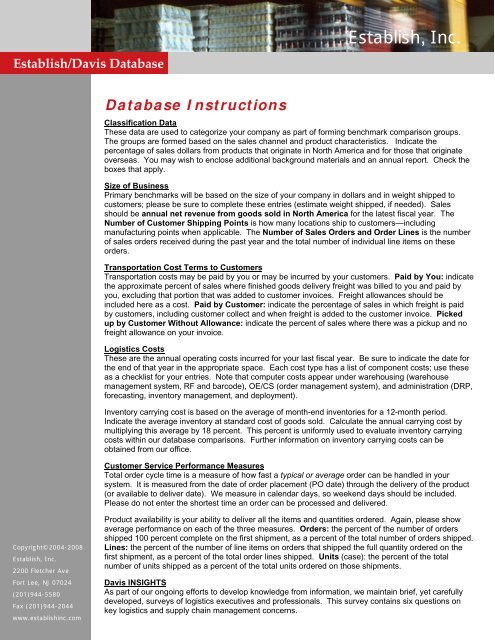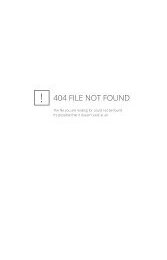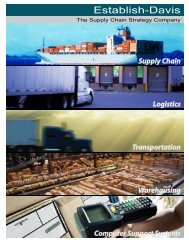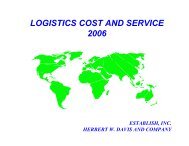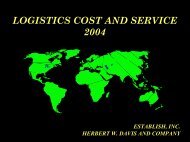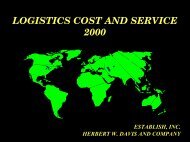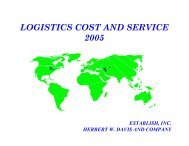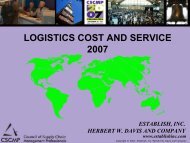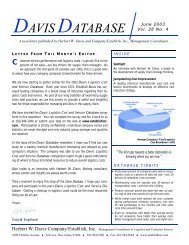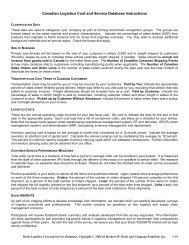Database Questionnaire - Supply Chain Consulting
Database Questionnaire - Supply Chain Consulting
Database Questionnaire - Supply Chain Consulting
You also want an ePaper? Increase the reach of your titles
YUMPU automatically turns print PDFs into web optimized ePapers that Google loves.
Establish/Davis <strong>Database</strong><br />
Copyright©2004-2008<br />
Establish, Inc.<br />
2200 Fletcher Ave<br />
Fort Lee, NJ 07024<br />
(201)944-5580<br />
Fax (201)944-2044<br />
www.establishinc.com<br />
<strong>Database</strong> Instructions<br />
Establish, Inc.<br />
Classification Data<br />
These data are used to categorize your company as part of forming benchmark comparison groups.<br />
The groups are formed based on the sales channel and product characteristics. Indicate the<br />
percentage of sales dollars from products that originate in North America and for those that originate<br />
overseas. You may wish to enclose additional background materials and an annual report. Check the<br />
boxes that apply.<br />
Size of Business<br />
Primary benchmarks will be based on the size of your company in dollars and in weight shipped to<br />
customers; please be sure to complete these entries (estimate weight shipped, if needed). Sales<br />
should be annual net revenue from goods sold in North America for the latest fiscal year. The<br />
Number of Customer Shipping Points is how many locations ship to customers—including<br />
manufacturing points when applicable. The Number of Sales Orders and Order Lines is the number<br />
of sales orders received during the past year and the total number of individual line items on these<br />
orders.<br />
Transportation Cost Terms to Customers<br />
Transportation costs may be paid by you or may be incurred by your customers. Paid by You: indicate<br />
the approximate percent of sales where finished goods delivery freight was billed to you and paid by<br />
you, excluding that portion that was added to customer invoices. Freight allowances should be<br />
included here as a cost. Paid by Customer: indicate the percentage of sales in which freight is paid<br />
by customers, including customer collect and when freight is added to the customer invoice. Picked<br />
up by Customer Without Allowance: indicate the percent of sales where there was a pickup and no<br />
freight allowance on your invoice.<br />
Logistics Costs<br />
These are the annual operating costs incurred for your last fiscal year. Be sure to indicate the date for<br />
the end of that year in the appropriate space. Each cost type has a list of component costs; use these<br />
as a checklist for your entries. Note that computer costs appear under warehousing (warehouse<br />
management system, RF and barcode), OE/CS (order management system), and administration (DRP,<br />
forecasting, inventory management, and deployment).<br />
Inventory carrying cost is based on the average of month-end inventories for a 12-month period.<br />
Indicate the average inventory at standard cost of goods sold. Calculate the annual carrying cost by<br />
multiplying this average by 18 percent. This percent is uniformly used to evaluate inventory carrying<br />
costs within our database comparisons. Further information on inventory carrying costs can be<br />
obtained from our office.<br />
Customer Service Performance Measures<br />
Total order cycle time is a measure of how fast a typical or average order can be handled in your<br />
system. It is measured from the date of order placement (PO date) through the delivery of the product<br />
(or available to deliver date). We measure in calendar days, so weekend days should be included.<br />
Please do not enter the shortest time an order can be processed and delivered.<br />
Product availability is your ability to deliver all the items and quantities ordered. Again, please show<br />
average performance on each of the three measures. Orders: the percent of the number of orders<br />
shipped 100 percent complete on the first shipment, as a percent of the total number of orders shipped.<br />
Lines: the percent of the number of line items on orders that shipped the full quantity ordered on the<br />
first shipment, as a percent of the total order lines shipped. Units (case): the percent of the total<br />
number of units shipped as a percent of the total units ordered on those shipments.<br />
Davis INSIGHTS<br />
As part of our ongoing efforts to develop knowledge from information, we maintain brief, yet carefully<br />
developed, surveys of logistics executives and professionals. This survey contains six questions on<br />
key logistics and supply chain management concerns.
Establish/Davis <strong>Database</strong><br />
Logistics Cost and Service <strong>Database</strong><br />
Company Name Contact Name<br />
Address Title<br />
CLASSIFICATION DATA<br />
Telephone Fax<br />
Email<br />
Company’s Industry Description and Principal Products<br />
Nature of Business: Products are Primarily:<br />
Manufacturing Retail <strong>Chain</strong> Durable Consumer<br />
Wholesale/Distributor Other Non-Durable Industrial<br />
SIZE OF BUSINESS TRANSPORTATION COST TERMS TO CUSTOMERS<br />
Establish, Inc.<br />
A. Net US Sales Dollars $ Percent of Sales on which Freight is:<br />
B. Weight Shipped to Customers lbs. Paid by You %<br />
C. Number of Customer Shipping Points Paid by Customer %<br />
D. Number of Sales Orders Picked up by Customer without Allowance %<br />
E. Number of Sales Order Lines Other %<br />
LOGISTICS COSTS Data for 12 Months Ending ______/______/______<br />
Total 100 %<br />
A. Finished Goods Transportation<br />
1. Primary Transportation.<br />
Domestic (From domestic plants/vendors to DCs and DC transfers) $<br />
International (From international plants/vendors to DC’s excluding duty) $<br />
2. Secondary Transportation. Delivery to customers. $<br />
Total Transportation $<br />
B. Finished Goods Warehousing. Plant, DC, public, and third-party warehouse costs for<br />
storage and handling of finished goods. Costs should include the following: labor, space,<br />
energy, equipment, computers (hardware and software), and material for packing and<br />
shipping. Warehousing $<br />
C. Order Entry/Customer Service (OE/CS). Costs should include the following: labor,<br />
space, energy, computers (hardware and software), and supplies. OE/CS $<br />
D. Administration of Distribution. Personnel and support costs for indirect management<br />
(central distribution staff, computers (hardware and software), inventory control, and<br />
transportation and traffic). Administration $<br />
E. Finished Goods Inventory Carrying Cost<br />
Average Inventory Value at Standard Cost $ Carrying Cost (Inventory Value x 0.18) $<br />
Average Finished Goods Inventory Turns<br />
To value the cost to carry inventory, does your company use: Total Logistics Cost $<br />
A specific rate for inventory carrying An internal hurdle rate Not sure/don’t know<br />
What is the rate currently used by your company to value the cost to carry inventory? %<br />
CUSTOMER SERVICE PERFORMANCE MEASURES<br />
A. Total Order Cycle Time (Customer PO to Delivery of Shipment) calendar days<br />
B. Percent of Orders Shipped Complete on the First Shipment %<br />
C. Percent of Lines Shipped Complete %<br />
D. Percent of Units Shipped Complete<br />
DAVIS INSIGHTS<br />
%<br />
A. What are the strongest forces driving your decisions in logistics and supply chain management today?<br />
B. What is the single most pressing issue you face today in managing a logistics or the supply chain organization?<br />
C. What is the single most pressing issue you face today in operating logistics and supply chain functions?<br />
D. What is the most difficult customer service requirement for your organization to satisfy?<br />
E. What are the most recent changes made to your logistics network?<br />
F. What is the most recent change your company has made in systems that support logistics?


